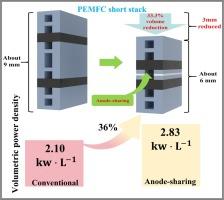A novel anode-sharing configuration to enhance the volumetric power density of short stack of proton exchange membrane fuel cells: An experimental and numerical simulation study
IF 10.9
1区 工程技术
Q1 ENERGY & FUELS
引用次数: 0
Abstract
One goal for developing proton exchange membrane fuel cells is to increase the volumetric power density, enabling them to compete with internal combustion engines. Hence, this work proposes a novel anode-sharing configuration for a two-unit short stack of proton exchange membrane fuel cells, which effectively decreases the volume of the stack by utilizing one anode gas channel to supply hydrogen to both units. The feasibility and optimal operating conditions of this novel configuration have been validated by experiments. Three-dimensional numerical simulations reveal that alterations in stack configuration do not influence the distribution of reactants. Yet, the temperature in the anode-sharing short stack is relatively high due to the accumulated heat in the shared anode without cooling, which may cause membrane dehydration and affect overall performance. These negative effects can be offset by increasing relative humidity. Moreover, the thermal management can be significantly improved by enhancing cooling of the cathode when scaling up. A six-unit anode-sharing stack equipped with an enhanced cooling flow field has reduced the volume by 33.3 % and increased the volumetric power density by 40 %. The anode-sharing stack can achieve a volumetric power density up to 7 kW/L, a step closer to that of the internal combustion engines.

一种提高质子交换膜燃料电池短堆体积功率密度的新型阳极共享结构:实验和数值模拟研究
发展质子交换膜燃料电池的一个目标是提高体积功率密度,使其能够与内燃机竞争。因此,本研究为质子交换膜燃料电池的两个单元短堆提出了一种新的阳极共享配置,通过利用一个阳极气体通道向两个单元提供氢气,有效地减少了堆的体积。实验验证了该结构的可行性和最佳运行条件。三维数值模拟结果表明,堆态的改变不会影响反应物的分布。然而,共用阳极短堆中的温度相对较高,因为共用阳极的热量在没有冷却的情况下积累,这可能导致膜脱水,影响整体性能。这些负面影响可以通过增加相对湿度来抵消。此外,当放大时,通过加强阴极的冷却可以显著改善热管理。配备了强化冷却流场的6单元阳极共享堆栈将体积缩小了33.3%,并将体积功率密度提高了40%。阳极共享堆栈可以实现高达7 kW/L的体积功率密度,更接近内燃机。
本文章由计算机程序翻译,如有差异,请以英文原文为准。
求助全文
约1分钟内获得全文
求助全文
来源期刊

Energy Conversion and Management
工程技术-力学
CiteScore
19.00
自引率
11.50%
发文量
1304
审稿时长
17 days
期刊介绍:
The journal Energy Conversion and Management provides a forum for publishing original contributions and comprehensive technical review articles of interdisciplinary and original research on all important energy topics.
The topics considered include energy generation, utilization, conversion, storage, transmission, conservation, management and sustainability. These topics typically involve various types of energy such as mechanical, thermal, nuclear, chemical, electromagnetic, magnetic and electric. These energy types cover all known energy resources, including renewable resources (e.g., solar, bio, hydro, wind, geothermal and ocean energy), fossil fuels and nuclear resources.
 求助内容:
求助内容: 应助结果提醒方式:
应助结果提醒方式:


